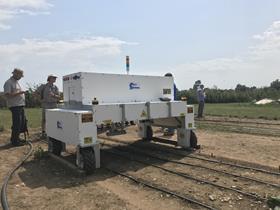
Research trials of a new automated weed-killing robot are reported to have reduced herbicide usage on crops by up to 95 per cent.
A recent trial in Reading demonstrated how the eyeSpot robot uses cameras to identify weeds in vegetable fields. It targets weeds individually and applies precise herbicide droplets with an ejector, which accurately fires treatment to the individual leaves of each weed.
“This is precision agriculture in action. The robot has significantly reduced use of herbicides, while practically eliminating any harm to non-target organisms,” said AHDB crop protection senior scientist Joe Martin.
Carried out at Reading University and part funded by AHDB, the research set out to protect the environment and help the industry manage with less access to crop protection products.
PhD researcher at the University of Reading, Nikolaos Koukiasas, who has been partly funded by AHDB and the Douglas Bomford Trust, said: “EyeSpot represents a paradigm shift to weed control by accurately targeting leaf-specific droplet applications.
“Preliminary results of manual droplet applications showed excellent weed control and a 95 per cent reduction of herbicide use in cabbages, and 74 per cent in leeks.”
With big data becoming instrumental in farming, eyeSpot’s imagery also has the potential to be used for the observation of growth rates, enabling accurate scheduling of operations, early yield estimates and the detection of crop stress.
Alistair Murdoch, professor of weed science at Reading, said: “Yields and profitability are likely to equal or exceed those achieved by conventional herbicide treatments without applying any chemical to the crop.
“The environment also benefits greatly by reducing the need for mechanical weed control, eliminating spray drift and reducing the possibility of chemicals entering the surrounding area.”
US-based Concurrent Solutions and Knight Farm Machinery in the East Midlands are among the companies involved in the development of the robot, with funding coming from the the Douglas Bomford Trust and AHDB.
Opportunities for commercialisation are being explored, and if successful in later stages of trials, eyeSpot would be developed to serve the UK and potentially other global markets.



